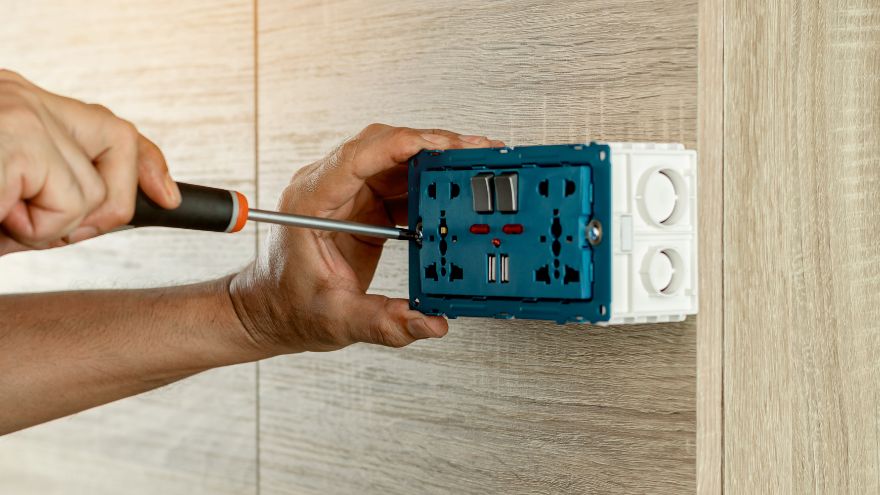The correct arrangement of electrical sockets is a key aspect of designing electrical installations in every home or apartment. Sockets must not only be functional, but also comply with safety standards. In this article, we explain at what height sockets should be mounted, what installation sockets are, and how to ensure safety during their installation. You will also learn why it is worth using proven equipment available at the Onninen wholesaler.

Check the installation sockets at the Onninen wholesaler
What standards define the height of electrical sockets?
In Poland, the rules for the installation of electrical sockets are regulated by the provisions contained in the PN-IEC 60364 standard. This document specifies, among other things, the rules for placing sockets in relation to the floor level and the distance from devices that constitute a source of access to water (sink or washbasin).
 It is worth remembering that these standards are primarily guidelines aimed at increasing safety and ergonomics of use.
It is worth remembering that these standards are primarily guidelines aimed at increasing safety and ergonomics of use.
Installation sockets should be selected depending on the needs and type of installation.
The most common types of sockets:
- Flush-mounted sockets – designed for installation in walls, they provide aesthetic appearance and durability.
- Surface-mounted sockets – used in technical rooms, such as garages or basements, where aesthetics are less important.
- Plug sockets with additional functions, e.g. surge protection, USB charger or built-in switch.
In residential premises, the standard height of socket installation is from 30 cm to 140 cm above the floor, depending on the purpose. For example:
- In living rooms and bedrooms, plug sockets are usually mounted at a height of approximately 30 cm.
- Kitchen sockets located above countertops should be installed at a height of 100 cm to 120 cm above the floor .
- In bathrooms, the principle of maintaining a safe distance applies - installation sockets must be installed at least 60 cm from water sources such as washbasins , showers or sinks .
Standards and good practices for installing electrical sockets
 The safe arrangement of electrical sockets largely depends on the type of room and the planned location of the devices. It is important to mount electrical sockets at a height that allows for convenient connection of devices such as refrigerators, dishwashers or other household appliances.
The safe arrangement of electrical sockets largely depends on the type of room and the planned location of the devices. It is important to mount electrical sockets at a height that allows for convenient connection of devices such as refrigerators, dishwashers or other household appliances.
When planning sockets in the kitchen, the following rules should be taken into account:
- Plug sockets for stationary appliances, such as a refrigerator or oven, should be located behind the appliance at a height of approximately 30 cm from the floor.
- Kitchen sockets above the worktop are mounted at a height of 100 cm to 120 cm above the floor, which ensures easy access during use.
In bathrooms, where the risk of contact with water is particularly high, special precautions apply. The installation of installation sockets at a distance from water sources should comply with the IP44 standard, which guarantees protection against moisture and water splashing from different directions.
How far apart should sockets be in the kitchen?
 The kitchen is a place where sockets must be arranged in a thoughtful way and adapted to the specifics of the room. The appropriate arrangement of electrical sockets in this room allows you to avoid overloading the installation and ensures safety of use.
The kitchen is a place where sockets must be arranged in a thoughtful way and adapted to the specifics of the room. The appropriate arrangement of electrical sockets in this room allows you to avoid overloading the installation and ensures safety of use.
Recommendations for the location of sockets in the kitchen:
- Flush-mounted sockets behind large appliances, such as refrigerators or ovens, must be located 20–30 cm above the floor.
- Above the worktop, it is worth installing at least two sockets for every meter of the worktop length. Such plug sockets are mounted at a height of 100 to 120 cm.
- Avoid installing sockets directly above the stove or near the sink, maintaining a minimum distance of 60 cm from water sources.
Choosing the right height and positioning of sockets affects the comfort of use and safety. Installing sockets at the wrong height can make access to devices difficult or lead to overloading the installation. Safety regulations clearly specify minimum distances from water sources to prevent the risk of electric shock.
A properly installed socket is not only a matter of aesthetics, but above all safety and functionality. Both flush-mounted and surface-mounted sockets should be installed in accordance with standards and principles of good practice.
We encourage you to use the offer of the Onninen wholesaler, where you will find everything you need for electrical installations , from installation sockets to assembly accessories. Check the offer now and take care of the safety and quality of your installation!